child seat AUDI S7 2016 Owners Manual
[x] Cancel search | Manufacturer: AUDI, Model Year: 2016, Model line: S7, Model: AUDI S7 2016Pages: 294, PDF Size: 73.82 MB
Page 5 of 294
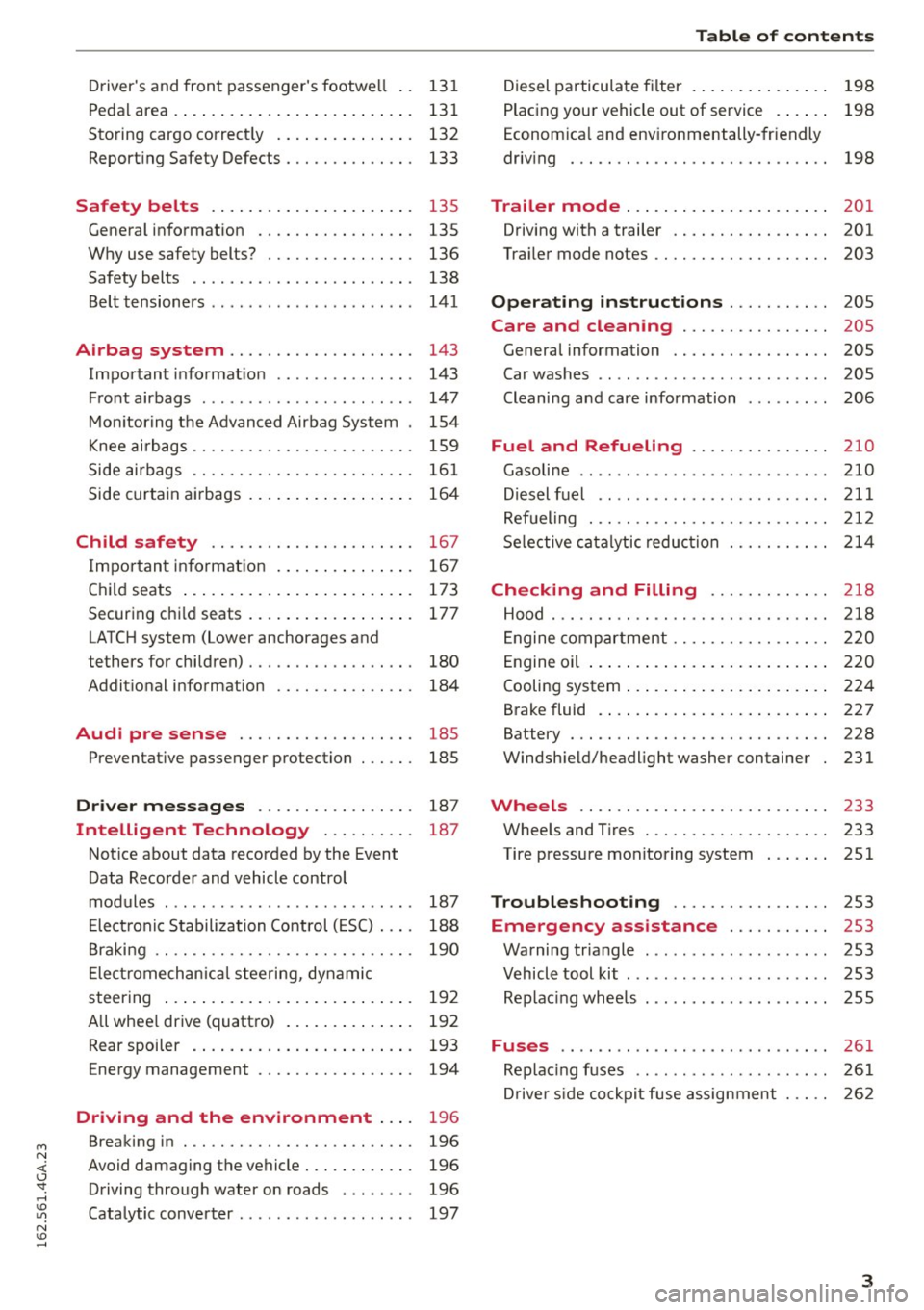
M N <( (.J
'SI: ,...., \!) 1.1'1
N \!) ,....,
Driver's and front passenger's footwell . . 131
Pedal area . . . . . . . . . . . . . . . . . . . . . . . . . . 131
Storing cargo correct ly . . . . . . . . . . . . . . . 132
Reporting Safety Defects . . . . . . . . . . . . . . 133
Safety belts . . . . . . . . . . . . . . . . . . . . . . 13 5
General information . . . . . . . . . . . . . . . . . 135
Why use safety belts? . . . . . . . . . . . . . . . . 136
Safety belts . . . . . . . . . . . . . . . . . . . . . . . . 138
Belt tensioners . . . . . . . . . . . . . . . . . . . . . . 141
Airbag system . . . . . . . . . . . . . . . . . . . . 143
Important informat ion . . . . . . . . . . . . . . . 143
Front airbags ............... .. .... . .
Monitoring the Advanced Airbag System . 147
154
Knee airbags . . . . . . . . . . . . . . . . . . . . . . . . 159
Side airbags . . . . . . . . . . . . . . . . . . . . . . . . 161
Side curtain airbags . . . . . . . . . . . . . . . . . . 164
Child safety . . . . . . . . . . . . . . . . . . . . . . 167
I mportant informat ion . . . . . . . . . . . . . . . 167
Child seats . . . . . . . . . . . . . . . . . . . . . . . . . 173
Securing chi ld seats . . . . . . . . . . . . . . . . . . 177
LATCH system (Lower anchorages and
tethers for children) . . . . . . . . . . . . . . . . . . 180
Addit ional information 184
Audi pre sense . . . . . . . . . . . . . . . . . . . 185
Preventat ive passenger protection
185
Driver messages . . . . . . . . . . . . . . . . . 187
Intelligent Technology . . . . . . . . . . 187
Notice about data recorded by the Event
Data Recorder and vehicle control
modules . . . . . . . . . . . . . . . . . . . . . . . . . . . 187
E lect ron ic Stabilization Control (ES C) . . . . 188
Braking . . . . . . . . . . . . . . . . . . . . . . . . . . . . 190
Electromechanical steering, dynamic
steering . . . . . . . . . . . . . . . . . . . . . . . . . . . 192
All whee l drive (quattro) . . . . . . . . . . . . . . 192
Rear spoiler . . . . . . . . . . . . . . . . . . . . . . . . 193
Energy management . . . . . . . . . . . . . . . . . 194
Driving and the environment . . . . 196
Breaking in . . . . . . . . . . . . . . . . . . . . . . . . . 196
Avoid damag ing the vehicle . . . . . . . . . . . . 196
Driving through water on roads . . . . . . . . 196
Cata lytic converter . . . . . . . . . . . . . . . . . . . 197
Table of contents
Diesel particulate filter . . . . . . . . . . . . . . . 198
Placing your vehicle out of service . . . . . . 198
Econom ica l and env ironmentally-friendly
driving . . . . . . . . . . . . . . . . . . . . . . . . . . . . 198
Trailer mode . . . . . . . . . . . . . . . . . . . . . . 201
Driving with a trailer . . . . . . . . . . . . . . . . . 201
Tra iler mode notes . . . . . . . . . . . . . . . . . . . 203
Operating instructions . . . . . . . . . . . 205
Care and clean ing . . . . . . . . . . . . . . . . 205
General information . . . . . . . . . . . . . . . . . 20S
Car washes . . . . . . . . . . . . . . . . . . . . . . . . . 205
Cleaning and care information 206
Fuel and Refueling .......... ... .. 210
Gasoline . . . . . . . . . . . . . . . . . . . . . . . . . . . 210
Diesel fuel . . . . . . . . . . . . . . . . . . . . . . . . . 211
Refueling . . . . . . . . . . . . . . . . . . . . . . . . . . 212
Selective catalytic reduction 214
Checking and Filling . . . . . . . . . . . . . 2 18
Hood ... .. .. .. .. .. ........... .. .. .. 218
Engine compartment . . . . . . . . . . . . . . . . . 220
En gine oil . . . . . . . . . . . . . . . . . . . . . . . . . . 220
Cooling system . . . . . . . . . . . . . . . . . . . . . . 224
Brake fluid . . . . . . . . . . . . . . . . . . . . . . . . . 227
Battery . . . . . . . . . . . . . . . . . . . . . . . . . . . . 228
Windshield/headlight washer container
231
Wheels ...... .. ............. .... .. 233
Wheels and Tires . . . . . . . . . . . . . . . . . . . . 233
Tire pressure monitoring system 251
Troubleshooting . . . . . . . . . . . . . . . . . 253
Emergency assistance . . . . . . . . . . . 253
Warning triangle . . . . . . . . . . . . . . . . . . . . 253
Vehicle tool kit . . . . . . . . . . . . . . . . . . . . . . 253
Replacing wheels . . . . . . . . . . . . . . . . . . . . 255
Fuses ....... ... .. .............. ... 261
Replacing fu ses . . . . . . . . . . . . . . . . . . . . . 261
Driver sid e cockpit fuse assignment . . . . . 262
3
Page 54 of 294

Seats and storage
Seats and storage
General information
Why is your seat adjustment so important?
The safety belts and the airbag system can only
provide maximum protection if the front seats are correctly adjusted .
There are various ways of adjusting the front
seats to provide safe and comfortable support
for the dr iver and the front passenger . Adjust
your seat properly so that :
- you can easily and quickly reach all the switches
and controls in the instrument panel
- your body is properly supported thus reducing
physical stress and fatigue
- the safety belts and a irbag system can offer
maximum protection
¢ page 143.
In the following sections, you will see exactly
how you can best adjust your seats.
There are special regulations and instructions for
installing a child seat on the front passenger's
seat. Always fo llow the information regarding
child safety provided in ¢
page 167, Child safe
ty .
A WARNING
Incorrect seating position of the driver and all
other passengers can resu lt in serious person
al injury .
- Always keep your feet on the floor when the
vehicle is in motion - never put your feet on
top of the instrument panel, out of the win dow or on top of the seat cushion. This ap
plies espec ially to the passengers. If you r
seating pos ition is incorrect, you increase
the risk of injury in the case of sudden brak
ing or an accident . If the airbag inf lates and
the seating position is incorrect, this could
result in personal injury or even death.
- It is important for both the driver and front
passenger to keep a distance of at least 10 inches (25 cm) between themselves and
the steering wheel and/or instrument panel. If you're sitting any closer than this, the air
bag system cannot protect you properly. In
52
addition, the front seats and head restraints
must be adjusted to your body height so
that they can give you maximum protection.
- Always try to keep as much distance as pos
sible between yourself and the steer ing
wheel or instrument panel.
- Do not adjust the driver's or front passeng er's seat while the vehicle is moving. Your
seat may move unexpectedly, causing sud
den loss of vehicle control and personal in
jury . If you adjust your seat while the vehicle
is moving, you are out of position.
Driver's seat
The correct seat position is important for safe
and relaxed driving .
We recommend that you adjust the driver's seat
in the following manner:
.,. Adjust the seat in fore and aft direction so that
you can easily push the pedals to the floor
while keeping your knees slightly bent¢&.
in
Why is your seat adjustment so important? on
page 52 .
.,. Adjust the backrest so that when you sit with
your back against the backrest, you can still
grasp the top of the steering wheel.
.,. For adjustable head restraints: adjust the head
restraint so the upper edge is as even as possi
ble with the top of your head. If that is not pos
sible, try to adjust the head restraint so that it
is as close to this position as possible
¢page 55. Move the head restraint so that it
is as close to the back of the head as possible.
A WARNING
Never place any objects in the dr iver's foot
well. An object could get into the pedal area
and interfere with pedal function. In case of
sudden braking or an acc ident, you would not
be ab le to brake or accelerate.
Page 55 of 294
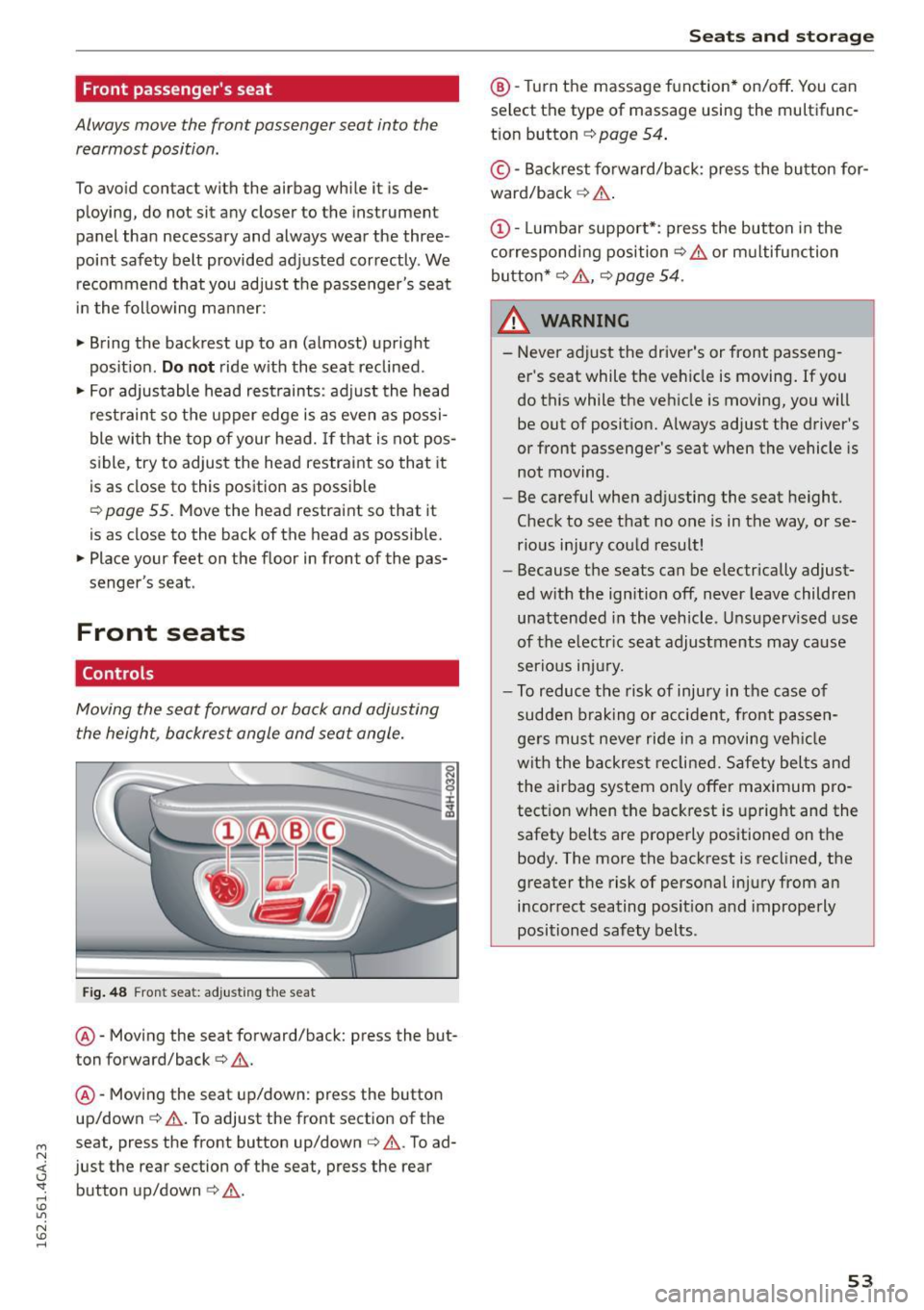
M N <( I.J -
Front passenger's seat
Always move the front passenger seat into the rearmost position .
To avoid contact with the airbag while it is de
ploying, do not sit any closer to the instrument
panel than necessary and always wear the three
point safety belt provided adjusted correctly . We
recommend that you adjust the passenger's seat
in the following manner:
.. Bring the backrest up to an (almost) upright
position .
Do not ride with the seat reclined .
.. For adjustable head restraints: adjust the head
restraint so the upper edge is as even as possi
ble with the top of your head. If that is not pos
sible, try to adjust the head restraint so that it
is as close to this position as possible
c:::> page 55. Move the head restraint so that it
is as close to the back of the head as possible.
.. Place your feet on the floor in front of the pas
senger's seat .
Front seats
Controls
Moving the seat forward or back and adjusting
the height, backrest angle and seat angle.
Fig. 48 Front seat: adjusting the seat
@-Moving the seat forward/back: press the but
ton forward/back ¢ .&,.
@ -Moving the seat up/down: press the button
up/down
c:::> .&, . To adjust the front section of the
seat, press the front button up/down
c:::> .&, . To ad
just the rear section of the seat, press the rear button up/down
c:::> .&,.
Seats and storage
@ -Turn the massage function* on/off. You can
select the type of massage using the multifunc
tion button
c:::> page 54.
© -Backrest forward/back: press the button for
ward/back ¢.&, .
(D-Lumbar support* : press the button in the
corresponding position
c:::> .&. or multifunction
button*¢ .&.,
c:::> page 54 .
& WARNING
=
-Never adjust the driver's or front passeng-
er 's seat while the vehicle is moving. If you
do this while the vehicle is moving, you will
be out of position. Always adjust the driver's
or front passenger's seat when the vehicle is
not moving.
- Be careful when adjusting the seat height.
Check to see that no one is in the way, or se
rious injury could result!
- Because the seats can be electrically adjust
ed with the ignition off, never leave children
unattended in the vehicle . Unsupervised use
of the electric seat adjustments may cause
serious injury.
- To reduce the risk of injury in the case of
sudden braking or accident, front passen
gers must never ride in a moving vehicle
with the backrest reclined. Safety belts and
the airbag system only offer maximum pro
tect ion when the backrest is upright and the
safety belts are properly positioned on the
body. The more the backrest is reclined, the
greater the risk of personal injury from an incorrect seating position and improperly
positioned safety belts.
-
53
Page 56 of 294
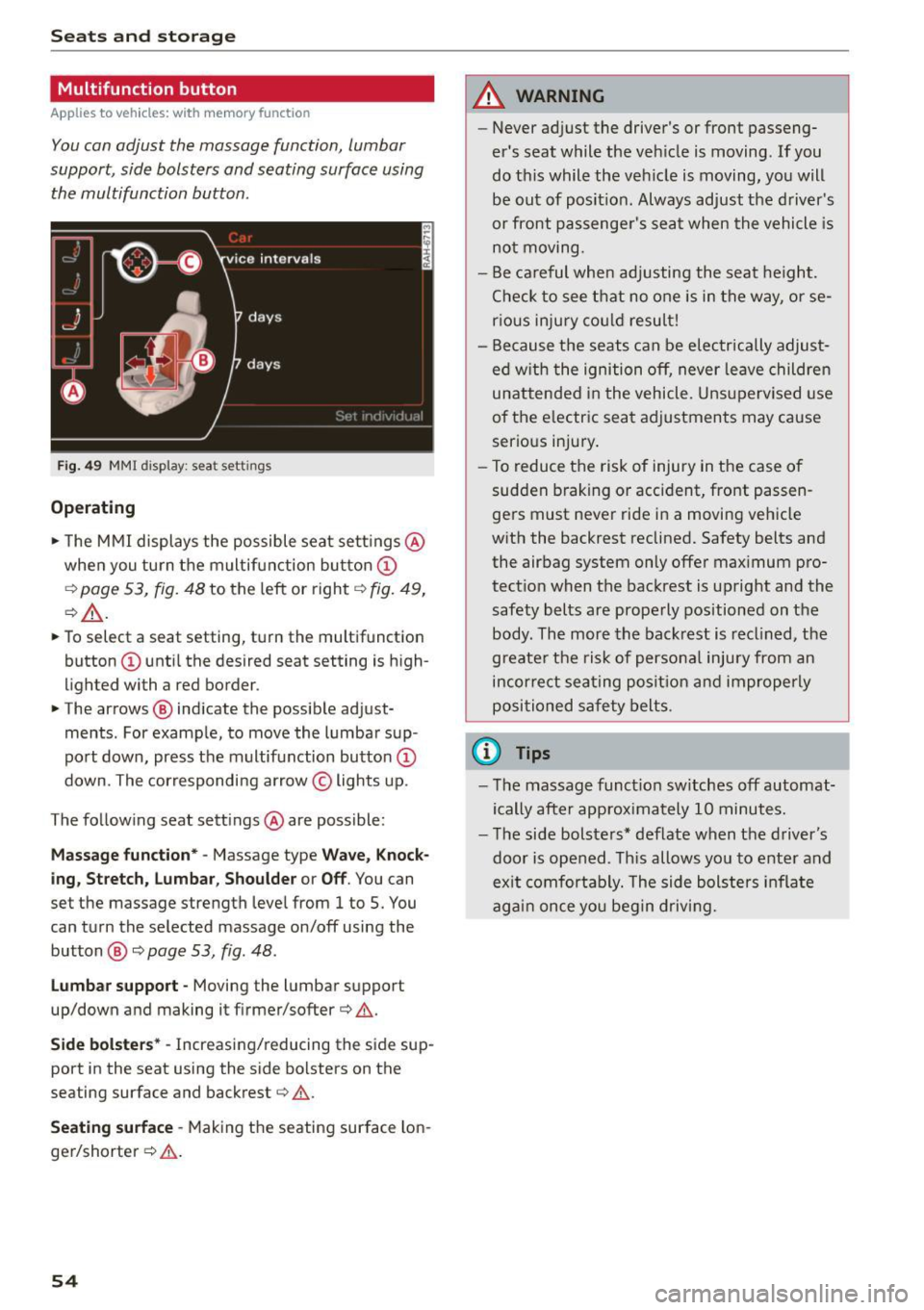
Seats and storag e
Multifunction button
Applies to vehicles: with memory function
You con adjust the massage function, lumbar
support, side bolsters and seating surface using
the multifunction button .
Fig . 4 9 MMI display: seat settings
Operating
.. The MMI displays the possible seat sett ings @
when you tu rn the m ultif unction button @
¢
page 53, fig. 48 to the left or right¢ fig. 49,
¢£ .
.. To select a seat setting, turn the multifunction
button
(D unti l the desired seat setting is h igh
lighted with a red border .
.. The arrows @ indicate the possib le adjust
ments . For example, to move the lumbar sup
po rt down, press the multifunction button
(D
down. The corresponding arrow © lights up .
The following seat sett ings @are possible:
Mas sag e function* -Massage type Wave, K nock
ing, Stret ch , Lumbar , Shoulder or Off .
You can
set the massage strength level from 1 to 5. You
can turn the selected massage on/off using the
button @¢
page 53, fig . 48.
L u mbar support -Moving the lumbar support
up/down and making it firmer/softer¢ &,.
Side bolst ers* -Increasing/reducing the side sup
port in the seat using the side bolsters on the
seating surface and backrest¢&, .
Se ating surfac e -Making the seating surface lon
ge r/shorter ¢ &, .
54
A WARNING
-Never adjust the driver's or front passeng
er's seat while the veh icle is moving. If you
do this while the veh icle is moving, you will
be out of posit ion . Always adjust the d river's
or front passenger's seat when the vehicle is
no t moving.
- Be careful when adjusting the seat he ight.
Check to see that no one is in the way, or se
r io us inju ry co uld resul t!
- Because the seat s can be elec trically adjust
ed w ith the ignition off, never leave children
unattended in the vehicle. Unsupervised use
of the e lectric seat adjustments may cause
serious injury .
- To reduce the risk of injury in the case of
sudden b raking or accident, front passen
gers must never ride in a moving veh icle
with the backrest reclined. Safety belts and
the airbag system only offer max imum pro
tect ion when the backrest is upright and the
safety belts are properly positioned on the
body . The more the backrest is recl ined, t he
greater the ris k of persona l inju ry from an
incor rect seating posit ion and imprope rly
positioned sa fety belts .
(D Tips
- The massage funct ion sw itches off automat
ically after approximately 10 minutes.
- The side bolsters* deflate when the d river's
door is ope ned . Th is allows you to enter and
ex it comfortably. The side bolsters i nflate
ag ain once you begin drivi ng.
Page 58 of 294
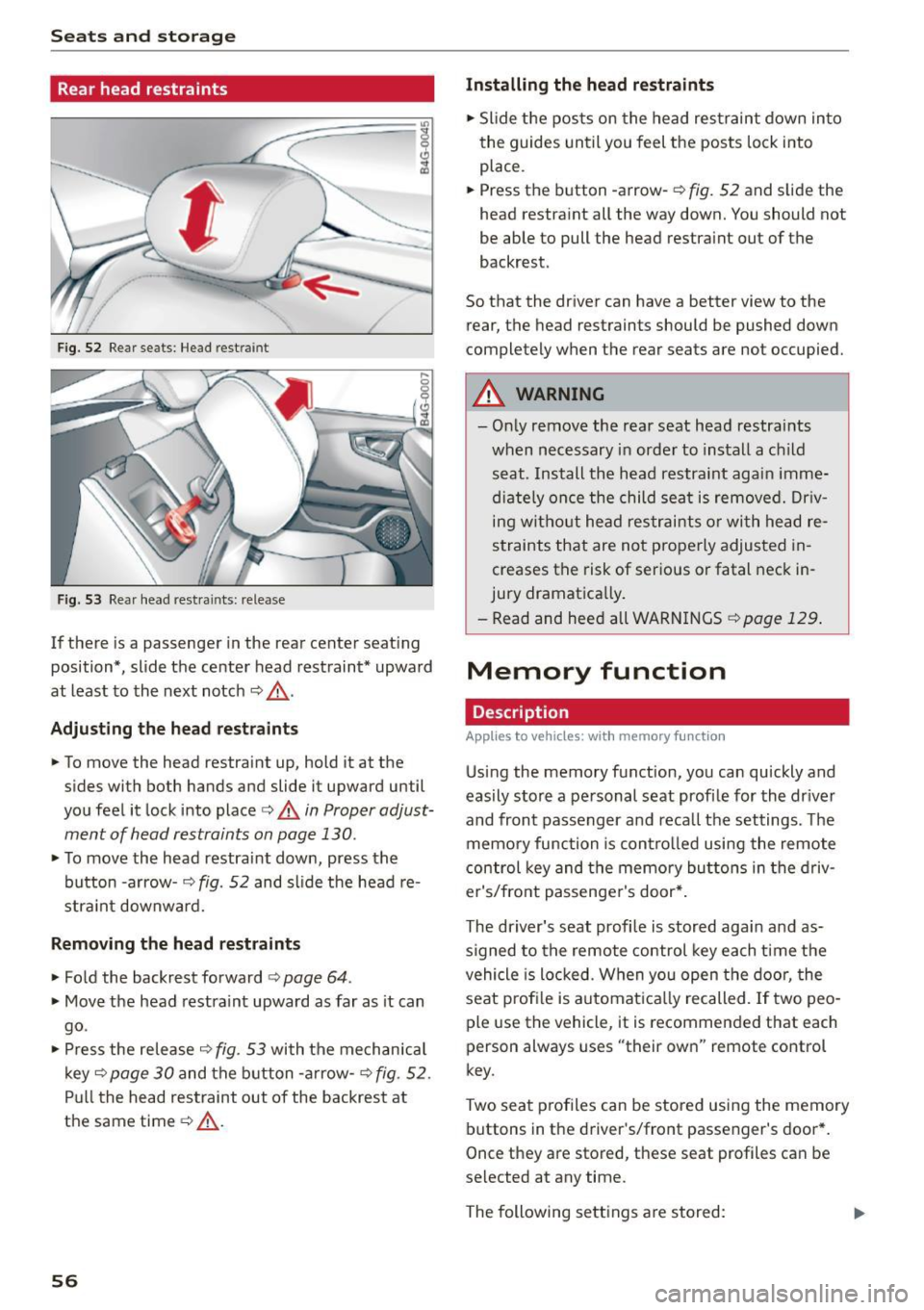
Seats and storag e
Rear head restraints
Fig. 52 Rear seats: Head rest ra in t
Fig. 53 Rear head restra ints: release
If there is a passenger in the rear center seat ing
position* , slide the center head restraint* upward
at least to the next notch
~ ,&. .
Adjust ing th e he ad res trai nts
• To move the head restra int up, hold it at the
sides with both hands and slide it upward until
you feel it lock into place
c:> A in Proper adjust
ment of head restraints on page
130.
• To move the head restraint down, press the
button -arrow-
c;> fig. 52 and slide the head re
stra int downward.
R emo ving the h ead re straint s
• Fold the backrest forward c:> page 64.
• Move the head restra int upward as far as it can
go .
• Press the release
c:> fig. 53 with the mechan ica l
key ~
page 30 and the b utton -a rrow-c:> fig . 52 .
Pull the head restraint out of the backrest at
the same time
c:> .&_ .
56
Installing the he ad re stra ints
• Slide the posts on the head restraint down into
the guides until you feel the posts lock into
place .
• Press the button -arrow-
c:> fig. 52 and s lide the
head restra int all the way down. You should not
be able to pull the head restra int out of the
backrest.
So that the driver can have a better view to the rear, the head restraints should be pushed down
completely when the rear seats are not occupied.
A WARNING
- On ly remove the rear seat head restra ints
when necessary in order to install a c hild
seat . Install the head restraint again imme
diate ly once the child sea t is removed. Dr iv
ing without head restraints o r with head re
straints that are not properly adjusted in
creases the risk of serious or fatal neck in
jury dramatically.
- Read and heed a ll WARN INGS
c:> page 129 .
Memory function
Description
Applies to vehicles : with memory f un ction
Us ing the memory function, you can quickly and
eas ily store a pe rsonal seat profi le for the driver
and front passenger and reca ll the settings . The
memory function is control led using the remote
control key and the memory buttons in the driv
er's/front passenger's door* .
-
The driver's seat profile is stored aga in and as
signed to the remote control key each time the
vehicle is locked. When you open the door, the
seat prof ile is automat ica lly recalled. If two peo
ple use the veh icle, it is recommended that each
person always uses "their own" remote control
key.
Two seat p rofiles can be stored using the memory
buttons in the dr iver's/front passenger's door *.
Once they are stored, these seat profiles can be
selected at any time.
The following sett ings a re stored:
Page 61 of 294

M N <( I.J "". rl I.O
"' N I.O rl
12 Volt sockets
Applies to vehicles: with 12-volt sockets
Fig. 58 Luggage compartme nt s ide trim panel: Socket
Fig. 59 Rear center console example: Sockets
0 0 9 (!) ., ID
~ To reach the 12-volt socket in the luggage com
partment, press the net down or remove the
bracket from the mounts
c::> fig. 58.
There are additional 12 Volt socket in the center
console under the center armrest* and in the rear
c::> fig. 59.
The 12-volt sockets can be used for electrical ac
cessories . The power usage must not exceed
120 watts.
_& WARNING
The sockets and the electr ical accessories con
nected to them operate only when the igni
tion is switched on. Incorrect usage can lead
to serious injuries or burns. To reduce the risk
of injuries, never leave children unattended in
the vehicle with the vehicle key.
(D Note
- To reduce the risk of damage to the vehicle electrical system, never attempt to charge
the vehicle battery by connecting accesso
ries that provide power, such as solar panels
Seats and storage
or battery chargers, to the 12 Volt sockets
or the cigarette lighter .
- To reduce the risk of damage to the sockets,
only use plugs that fit correctly .
Storage
(upholder
I
I
Fig. 60 Center console: cupho lder
Fig. 61 Rear center armrest: cup holder * extended
Front cupholder
~ To open the cupholder, tap the cover c::> fig. 60.
Rear cupholder*
~ To open the rea r cupholder, press on the sym
bol
ii @ c::> fig . 61.
~ To adjust the arm @, swing it in the direction
of the arrow .
~ Place the beverage in the ho lder and release
the arm. The arm swings back by itself and au
tomatically secures the beverage.
~ To close the rear cupholder, press on the center
section between the two arms and push the cu
pholder in the slot as far as it will go .
_& WARNING
Spilled hot liquid can cause an accident and
personal injury.
59
Page 67 of 294

M N <( I.J "". rl I.O
"' N I.O rl
Tie-downs and cargo net
The cargo net* prevents small objects from slid
ing .
Fig. 6 8 Locat ion of th e tie-downs in the lug gage com part·
ment
F ig. 69 Luggage compartme nt: ca rgo net•
~ To secure objects with the luggage compart
ment net*, fold the tie-down bracket upward
~ fig . 68 .
~ Insert the hooks on the luggage compar tment
ne t* into the t ie-downs
~ fig . 69.
~ Read and heed all WARNINGS~ page 132,
Storing cargo correctly.
A WARNING
Weak , damaged or improper straps used to
secure items to tie-downs can fa il during hard
braking or in a co llision and cause serious per
sonal injury .
- Always use suitable retaining straps and
properly secure items to the tie-downs in
the luggage compartment to help prevent
items from shift ing or fly ing forward.
- Never attach a child seat tether strap to a
t ie-down.
- For strength-related reasons, the mounting
hoo ks can only be used to secure objects
Seats and storage
weighing up to 10 lb. (5 kg) . Heav ier objects
will not be adequately secured -there is a
risk of injury.
Storage hooks
Fig . 70 Luggage compartmen t: S to ra ge hooks
You can also use the hooks to hang light pu rses,
bags, etc .
A WARNING
The hooks can hold a maximum w eig ht of
6 .6 lbs . (3 kg) . Heavier obj ect s are not ade
q uate ly secured. There is risk of personal i n
jur y.
Reversible mat
Appl ies to veh icles : w it h ca rgo mat
-
The reversible mat protects the luggage com
partment and bumper from dirt and scratches.
Fig. 71 Luggage compart men t: revers ible map w ith back ·
r est folded dow n.
You can use the reversible mat with the d irt-re
s istant side o r the decorative side. After loading
o r u nlo ading, fo ld up the revers ible ma t and
cl ose the luggage compartment lid. O nly s to re
the reversib le mat if it is dry.
65
Page 128 of 294
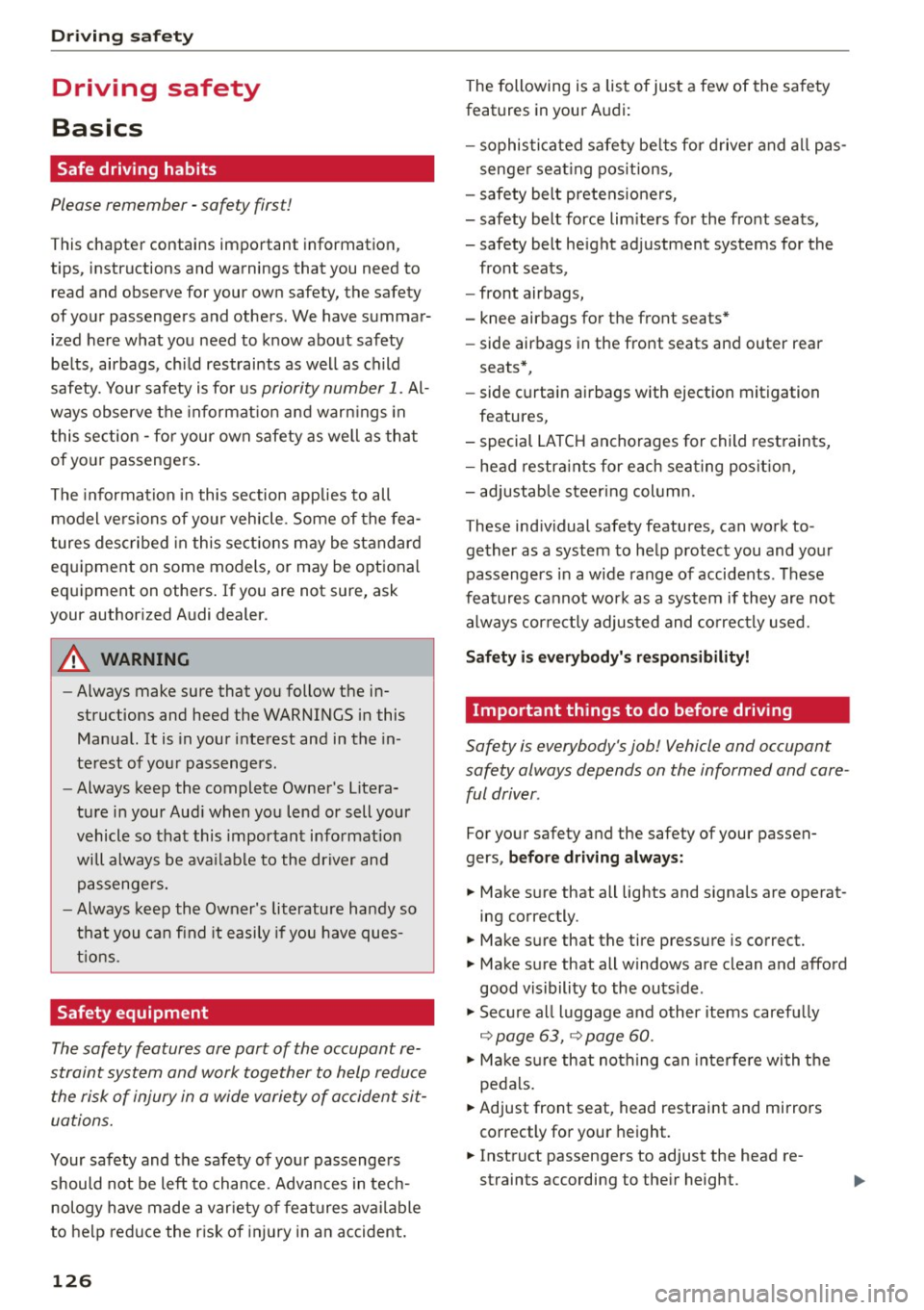
Driving safety
Driving safety
Basics
Safe driving habits
Please remember -safety first!
This chapter contains important information,
tips, instructions and warnings that you need to
read and observe for your own safety, the safety
of your passengers and others. We have summar ized here what you need to know about safety
belts, airbags, child restraints as well as child
safety. Your safety is for us
priority number 1. Al
ways observe the information and warnings in
this section - for your own safety as well as that
of your passengers .
The information in this section applies to all
model versions of your vehicle . Some of the fea
tures described in this sections may be standard
equipment on some models, or may be optional
equipment on others. If you are not sure, ask
your authorized Audi dealer.
A WARNING
- Always make sure that you follow the in
structions and heed the WARNINGS in this
Manual.
It is in your interest and in the in
terest of your passengers.
- Always keep the complete Owner's Litera
ture in your Audi when you lend or sell your
vehicle so that this important information
will always be available to the driver and
passengers.
-
- Always keep the Owner's literature handy so
that you can find it easily if you have ques
tions .
Safety equipment
The safety features are part of the occupant re
straint system and work together to help reduce
the risk of injury in a wide variety of occident sit
uations.
Your safety and the safety of your passengers
should not be left to chance. Advances in tech
nology have made a variety of features available
to help reduce the risk of injury in an accident.
126
The following is a list of just a few of the safety
features in your Audi:
-sophisticated safety belts for driver and all pas-
senger seating positions,
- safety belt pretensioners,
- safety belt force limiters for the front seats,
- safety belt height adjustment systems for the
front seats,
- front airbags,
- knee airbags for the front seats*
- side airbags in the front seats and outer rear
seats*,
- side curtain airbags with ejection mitigation
features,
- special LATCH anchorages for child restraints,
- head restraints for each seating position,
- adjustable steering column.
These individual safety features, can work to gether as a system to help protect you and your
passengers in a wide range of accidents . These
features cannot work as a system if they are not
always correctly adjusted and correctly used.
Safety is everybody's responsibility!
Important things to do before driving
Safety is everybody's job! Vehicle and occupant
safety always depends on the informed and care
ful driver.
For your safety and the safety of your passen
gers,
before driving always:
... Make sure that all lights and signals are operat
ing correctly.
... Make sure that the tire pressure is correct.
... Make sure that all windows are clean and afford
good visibility to the outs ide .
... Secure all luggage and other items carefully
~ page 63, ~page 60.
... Make sure that nothing can interfere with the
pedals .
... Adjust front seat, head restraint and mirrors
correctly for your height .
... Instruct passengers to adjust the head re
straints according to their height.
Page 129 of 294
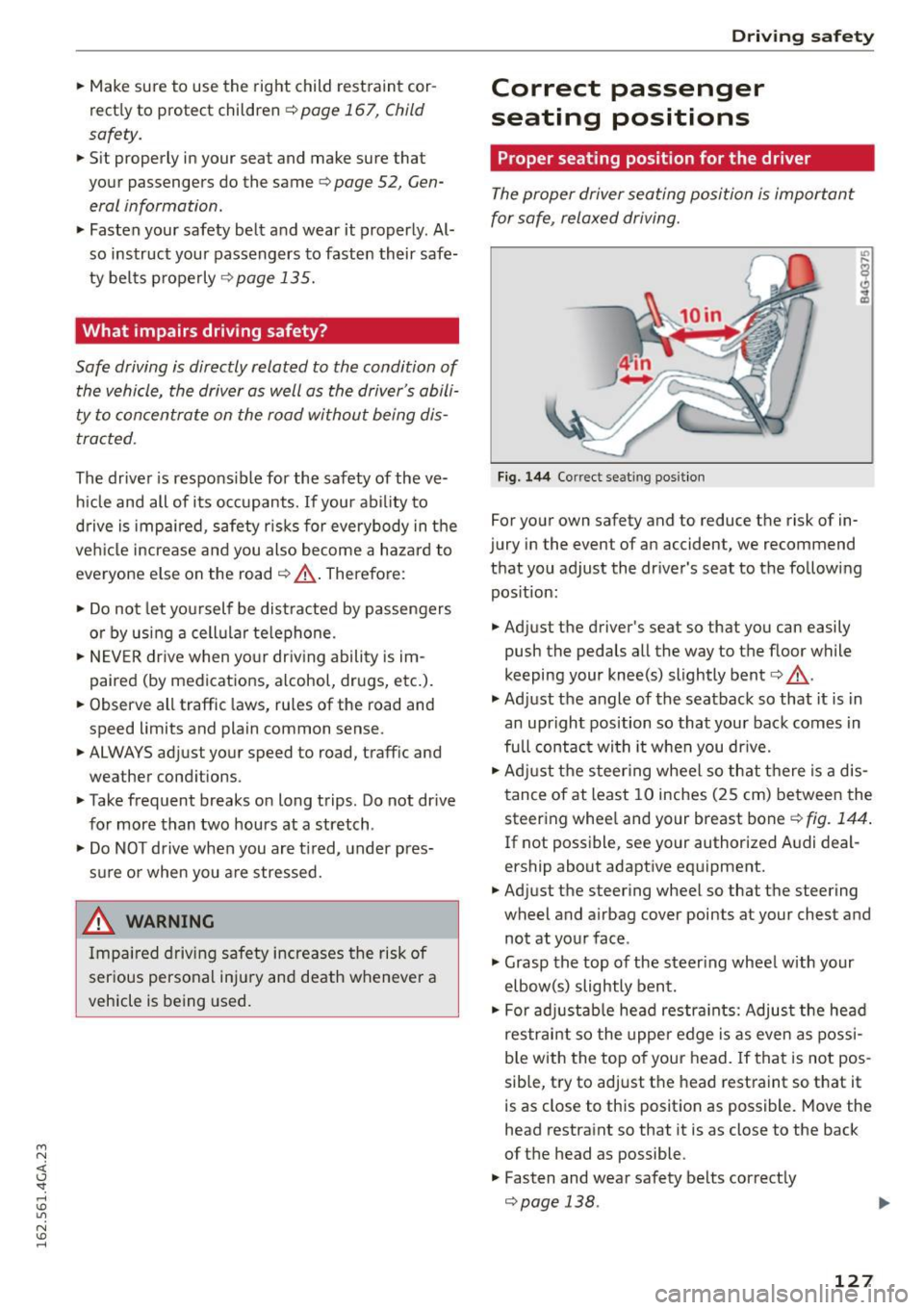
M N
.. Make sure to use the right child restraint cor
rect ly to protect children ¢
page 167, Child
safety .
.. Sit properly in your seat and make sure that
your passengers do the same ¢
page 52, Gen
eral information.
.. Fasten your safety belt and wear it properly . Al
so instruct your passengers to fasten their safe
ty belts properly ¢
page 135.
What impairs driving safety?
Safe driving is directly related to the condition of
the vehicle, the driver as well as the driver's abili
ty to concentrate on the road without being dis
tracted.
The driver is respons ible for the safety of the ve
hicle and all of its occ upan ts. If your ability to
drive is impaired , safety r isks for everybody in the
vehicle increase a nd you also become a hazard to
everyone else on the road ¢,A .Therefore:
.. Do not let yourself be distracted by passengers
or by using a cellular telephone .
.. NEVER drive when your driv ing ability is im
paired (by medications, alcohol, drugs, etc.).
.. Observe all traffic laws, rules of the road and
speed limits and plain common sense.
.,. ALWAYS adjust your speed to road, traffic and
weather cond itions.
.. Take frequent breaks on long trips. Do not dr ive
for more than two hours at a stretch .
.. Do NOT drive when you are t ired, under pres
sure or when you a re stressed.
_& WARNING
Impaired driving safety increases the risk of
serious personal injury and death whenever a
vehicle is being used.
.
Driving safety
Correct passenger
seating positions
Proper seating position for the driver
The proper driver seating position is important
for safe, relaxed driving .
Fig. 144 Correct se ating position
For your own safety and to reduce the risk of in
jury in the event of an accident, we recommend
that you adjust the driver's seat to the following pos ition:
.. Adjust the driver's seat so that you can easily
push the pedals all the way to the floor while
keeping your knee(s) slightly bent¢,&. .
.,. Adjust the angle of the seatback so that it is in
an upright position so that your back comes in
fu ll contact wi th it when you dr ive .
.. Adjust the steer ing wheel so that there is a dis
tance of at least 10 inches (25 cm) between the
steering whee l and your breast bone¢
fig. 144.
If not possible, see your authorized A udi deal
ership about adaptive equipment.
.. Adjust the steering wheel so that the steering
wheel and airbag cover points at your chest and
not at your face .
.,. Grasp the top of the steer ing wheel with your
elbow(s) slightly bent .
.. For adjustable head restra ints: Adjust the head
restraint so the upper edge is as even as possi
b le with the top of your head. If that is not pos
sible, try to adjust the head restraint so that it
is as close to this position as possible. Move the
head restraint so that it is as close to the back
of the head as possible.
.. Fasten and wear safety belts correctly
¢page 138. IJJ,-
127
Page 130 of 294
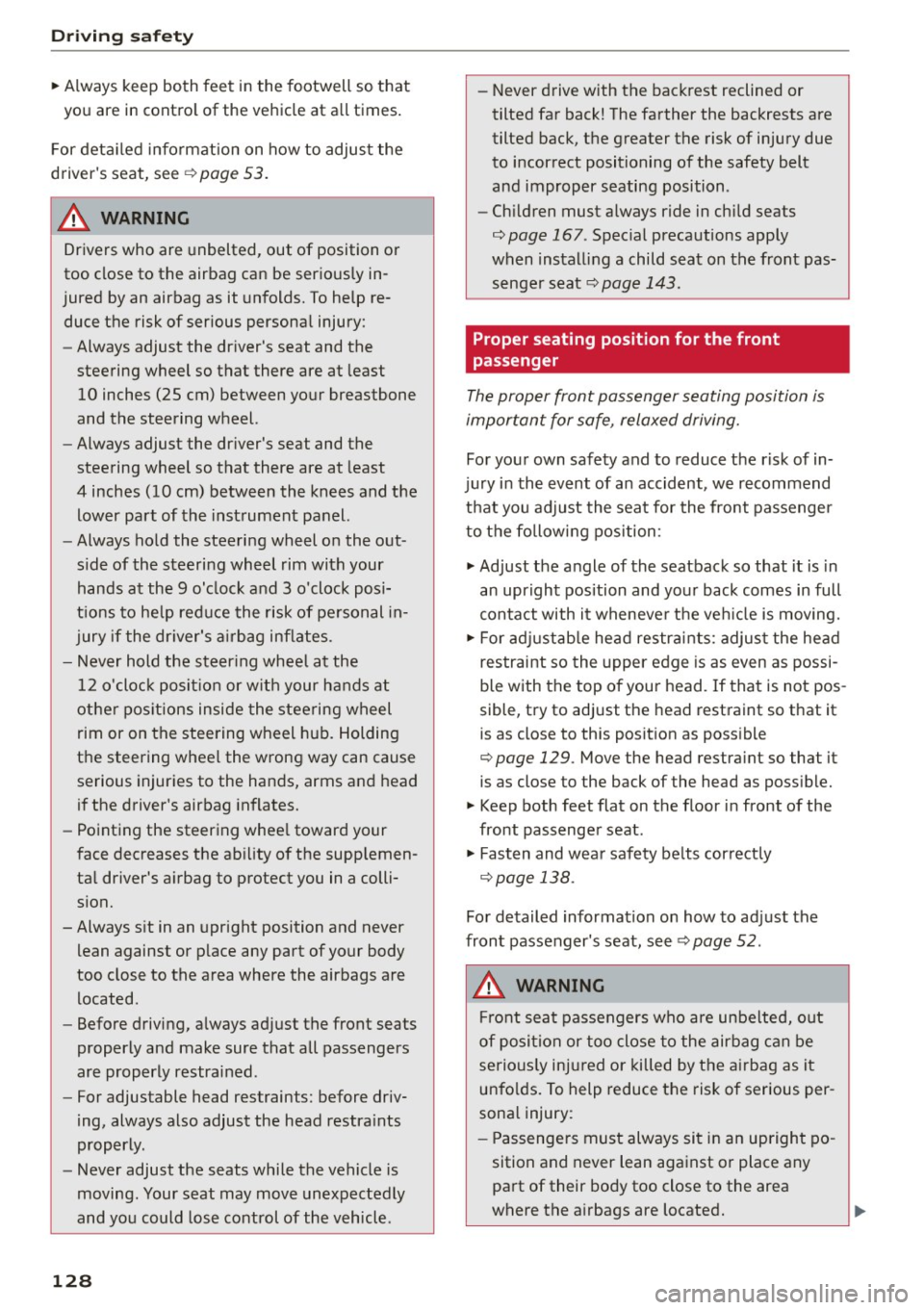
Driving safety
"'Always keep both feet in the footwell so that
you are in control of the vehicle at all times.
For detailed information on how to adjust the
driver's seat, see
¢ page 53.
.&_ WARNING
Drivers who are unbelted , out of position or
too close to the airbag can be seriously in
jured by an airbag as it unfolds. To help re
duce the risk of serious personal injury :
- Always adjust the driver's seat and the
steering wheel so that there are at least
10 inches (25 cm) between your breastbone
and the steering wheel.
- Always adjust the driver's seat and the
steering wheel so that there are at least
4 inches (10 cm) between the knees and the lower part of the instrument panel.
- Always hold the steering wheel on the out
side of the steering wheel rim with your
hands at the 9 o'clock and 3 o'clock posi
tions to help reduce the risk of personal in
jury if the driver's airbag inflates .
- Never hold the steering wheel at the
12 o'clock position or with your hands at
other positions inside the steering wheel
rim or on the steering wheel hub. Holding
the steering wheel the wrong way can cause
serious injuries to the hands, arms and head if the driver's airbag inflates.
- Pointing the steering wheel toward your
face decreases the ability of the supplemen
tal driver's airbag to protect you in a colli
sion.
- Always sit in an upright position and never
lean against or place any part of your body
too close to the area where the airbags are located .
- Before driving, always adjust the front seats
properly and make sure that all passengers
are properly restrained .
- For adjustable head restraints: before driv
ing, always also adjust the head restraints
properly .
- Never adjust the seats while the vehicle is
moving. Your seat may move unexpectedly
and you could lose control of the vehicle .
128
-
-Never drive with the backrest reclined or
tilted far back! The farther the backrests are
tilted back, the greater the risk of injury due
to incorrect positioning of the safety belt
and improper seating position .
- Children must always ride in child seats
¢
page 167 . Special precautions apply
when installing a child seat on the front pas senger seat¢
page 143.
Proper seating position for the front
passenger
The proper front passenger seating position is
important for safe, relaxed driving.
For your own safety and to reduce the risk of in
jury in the event of an accident, we recommend
that you adjust the seat for the front passenger
to the following position:
"' Adjust the angle of the seatback so that it is in
an upright position and your back comes in full
contact with it whenever the vehicle is moving.
"'For adjustable head restraints: adjust the head
restraint so the upper edge is as even as possi
ble with the top of your head. If that is not pos
sible, try to adjust the head restraint so that it
is as close to this position as possible
c:> page 129 . Move the head restraint so that it
is as close to the back of the head as possible.
"' Keep both feet flat on the floor in front of the
front passenger seat .
"'Fasten and wear safety be lts correctly
¢ page 138.
For detailed information on how to adjust the
front passenger's seat, see
¢ page 52 .
.&_ WARNING
Front seat passengers who are unbelted, out
of position or too close to the airbag can be
seriously injured or killed by the airbag as it
unfolds. To help reduce the risk of serious per
sonal injury :
- Passengers must always sit in an upright po
sition and never lean against or place any part of their body too close to the area
where the airbags are located.
Ill>